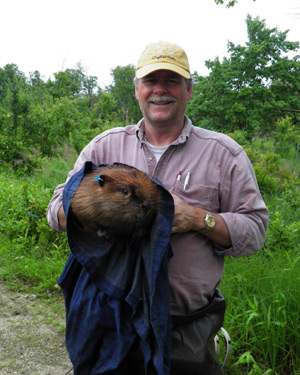I received an update yesterday from the hardy Judy Taylor-Atkinson of Port Moody Vancouver who is working to save the beavers at the development where she lives. She is doing a wonderful job focusing public attention on the beavers and getting the community interested in them. In fact she’s doing SUCH a fine job that I’m pretty sure at this point our beavers are jealous.
Yesterday she wrote this:
We had our first mini crisis last week when the beavers knocked down a large unwrapped black cottonwood tree and it landed on a homeowners fence, just damaging it slightly. I was immediately notified by people in our neighbourhood who love the beavers and I went to work posting messages on our community facebook page and notifying the city arborist, Steve, (who actually likes the beavers) and requesting the trees in that area be wrapped. Steve sent his two staff, Alex and Doug, who have been trained by Adrian Nelson on the proper way to wrap trees, the next day.
My facebook post read –
“Jim just came back and Silverlining landscape have removed the top of the aspen tree and Jim advised them to leave the branches and cuttings close to the stream bank for the beavers. We will meet with the city arborist today and wrap that stand of trees. The beavers have been eating mostly willow, dogwood, poplar and shrubs. Some trees will be wrapped and others will be left as food sources because there is a natural balance between beavers and trees. Beavers open up the tree canopy to let light in and smaller trees will grow. Some species of trees, like willow, have evolved with beavers and they actually grow faster if a beaver chops them down. The greenbelt is changing from a “stream” ecosystem to a “pond” ecosystem.”
That post seemed to settle everyone down (Jim is my husband). The next day, I posted a picture of Doug and Alex wrapping the trees with the post –
“Thank you to Doug and Alex for wrapping the cottonwoods this morning and to Steve (our city arborist) for his valuable knowledge about our trees along Pigeon Creek. Steve said they are busy right now removing downed trees throughout the city (due to a bad combination of drought followed by intense rain and now a cold snap).”
Thankfully, Steve, the city arborist seems to be quite supportive (and interested) in the beavers. When the beavers first turned up a year ago Steve didn’t know anything about them and now you should hear him! He knows what kind of trees they prefer (and why), which trees offer the most nutrition for beavers (cottonwoods, poplars) and he’s not concerned about the willows at all. He just has to make sure the trees don’t fall on a building and now he has a plan to wrap those trees. He has also been along the stream and is quite sure that the trees the beavers could potentially knock down will not fall away from the stream.
Isn’t that wonderful? She is committed to making beaver friends wherever she goes, and NOW those lucky beavers even have an arborist who is learning to love them! (Does Martinez even have an arborist? Or know the word?) I asked for her permission to share this because I think it is inspiring to others who are thinking of doing something similar. She and her husband are hard at work in the community encouraging, explaining and de-mystifying beaver behavior. I wish very much I could resist this little rhyme that has crept into my mind, because she deserves so much better, but there’s no avoiding it now.
Thank heavens for Judy
On duty
In Port Moody
There’s excellent beaver management news this morning from Idaho where the watershed guardians just installed a pond leveler for veterans day. Given the hard time that many beavers face in the Gem state, these critters are lucky indeed! Great work Mike Settell and team Pocatello!


“Thank you, Bruce, for serving on the Watershed Guardians board, providing inspiration, leadership and flatout hard work. We will honor your volunteerism by carrying on our work to help the Portneuf River Watershed, one beaver at a time!”







 Ten years ago today there was no Worth A Dam, no website, and no beaver community. There were only a bunch of citizens who thought it was a bad idea for their city to kill their beavers and showed up at a meeting to tell them so. This short clip of the UK documentary Beavers Las Vegas, produced by the independent film company Middle Child Productions, shows only the barest HINT of how many passionate and persuasive comments occurred. The clip I put together isn’t very long, but you should definitely watch all the way to the end to understand why it was so successful in changing the city council’s plan.
Ten years ago today there was no Worth A Dam, no website, and no beaver community. There were only a bunch of citizens who thought it was a bad idea for their city to kill their beavers and showed up at a meeting to tell them so. This short clip of the UK documentary Beavers Las Vegas, produced by the independent film company Middle Child Productions, shows only the barest HINT of how many passionate and persuasive comments occurred. The clip I put together isn’t very long, but you should definitely watch all the way to the end to understand why it was so successful in changing the city council’s plan.
 This month’s moon is called the beaver moon, and it was full Saturday.
This month’s moon is called the beaver moon, and it was full Saturday.





































